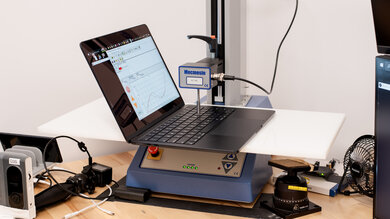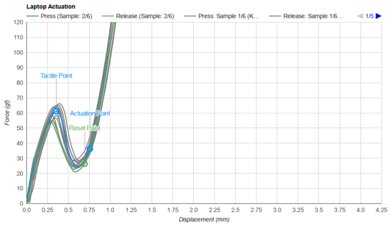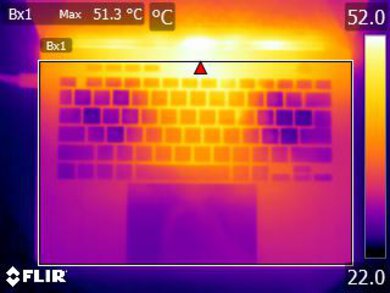
If you're going off to college, you'll need a laptop that can handle your school workload. Depending on your program, the best laptop for students may be a simple Chromebook, an ultraportable Windows laptop or MacBook, or a powerful mobile workstation. Preferably, you'll want a portable, well-built device with enough battery life to get you through the day. As you'll be working a lot on the laptop, you should also look for a device with features contributing to a good user experience, like a sharp and bright display, a comfortable keyboard, and a responsive touchpad. It's also important to consider the port selection if you use multiple peripherals or external displays. Of course, price is a big concern for some students, so we've also included picks for the best budget laptops for students.
We've bought and tested over 125 laptops. Below, you'll find our recommendations for the best laptops for college you can buy. You can also see our recommendations for the best student Chromebooks, the best lightweight laptops, and the best 15-16-inch laptops.
If you need to upgrade your wireless network at home, we recently launched router reviews; check out our list of the best Wi-Fi routers.
-
Best Laptop For College
SchoolSize13.6"Portability9.1Maximum Brightness453 cd/m²Typing Quality8.0Touchpad9.2Geekbench 5 (Synthetics)9.3Battery Life (Web Browsing)11.6 hrsFan Noise Under LoadN/AThe best laptop for college we've tested is the Apple MacBook Air 13 (2024). This premium model is ideal for college students who need a thin, light laptop to write papers, browse the web, and consume media. Apple's base M3 SoC is well suited to light productivity tasks and even some video editing and 3D graphics. Plus, it doesn't even need a cooling fan, so you won't have to worry about loud fan noise in classrooms and libraries. It provides an amazing user experience, sporting a sharp, bright display, a spacious keyboard, and a gigantic haptic touchpad; its battery life is also excellent, though it takes a while to charge to full. Port selection is its biggest weakness as it only has two USB-C/Thunderbolt 3 ports, and these ports will only output to two external displays if the lid is closed. The Apple MacBook Air 15 (2024) is also a good choice if you want a bigger screen with better-sounding speakers, but it costs more.
For Windows users, we recommend the HP Spectre x360 14 (2024). Also a premium ultraportable, this 14-inch model feels incredibly well built and provides an amazing user experience with its 120Hz 2.8k OLED display, spacious keyboard, and large haptic touchpad. It has Wi-Fi 7 wireless connectivity, an excellent 4k webcam, and a decent port selection with one USB-A and two USB-C/Thunderbolt 4s. Plus, you can flip the screen around into tablet mode since it's a 2-in-1 convertible. Pen support is present if you want to take handwritten notes, though you may have to buy the pen separately, depending on the retailer. Two things to bear in mind: the display doesn't get nearly as bright as the MacBook Air's, so visibility may be more of an issue in well-lit environments, and OLEDs are susceptible to permanent burn-in, meaning you'll have to take some active measures to prevent it, like hiding the taskbar.
-
Best Mid-Range Laptop For College
SchoolSize13"Portability8.9Maximum Brightness462 cd/m²Typing Quality7.5Touchpad7.3Geekbench 5 (Synthetics)9.0Battery Life (Web Browsing)10.0 hrsFan Noise Under Load39.0 dBAOur recommendation for a more affordable mid-range option is the HP Pavilion Aero 13 (2024). Configurable with Zen 4-based AMD Ryzen CPUs (up to a Ryzen 7 8840HS), this 13-inch ultraportable is well suited for light productivity tasks like text processing and web browsing, as well as some moderately intensive workloads like programming and photo editing. Its compact and lightweight design makes it easy to carry around, and you likely won't need to bring a charger, as the battery lasts around 10 hours of light use. It only comes with 16GB of soldered RAM, which is both good and bad, as you don't have to spend extra to upgrade (most laptops come with a measly 8GB on the base models), but you also don't have the option to get more or add more later. Thankfully, its standard M.2 NVMe SSD is user-replaceable.
As for the user experience, it's good, though a noticeable step down from the more premium models mentioned above. You can choose between an FHD+ or QHD+ IPS panel; both get bright enough to provide good visibility in well-lit settings. The keyboard feels spacious, albeit a tad fatiguing over an extended period, and the touchpad is responsive but makes some actions like dragging and dropping hard to perform. Its build quality is also inferior, as its aluminum and plastic chassis has a cheap, hollow feel and exhibits a fair amount of flexing. Additionally, the finish is prone to scratches even from everyday use. With all that said, this is still a very good device for college students if you can look past its unremarkable build.
-
Best Budget Laptop For College
SchoolSize16"Portability7.7Maximum Brightness253 cd/m²Typing Quality8.0Touchpad8.1Geekbench 5 (Synthetics)7.7Battery Life (Web Browsing)8.3 hrsFan Noise Under Load42.0 dBAThe best budget laptop for students we've tested is the ASUS Vivobook 16 M1605 (2023). This model feels well-built despite its low price, and it's relatively portable for a 16-inch device. You can get it with an AMD Ryzen 5 or Ryzen 7 CPU; both are more than adequate to handle most student workloads like text processing, web browsing, and video playback. RAM configuration is limited, as you can only get 8GB or 16GB. 16GB models are harder to find, but the upside is that the memory is user-upgradeable, so you can just get the 8GB model and pop in a SO-DIMM memory stick later on. Battery life is okay at around eight hours of light use.
The overall user experience is good. It has a comfortable keyboard, a large, responsive touchpad, and a decent 720p webcam. The display looks reasonably sharp but a bit dim and washed out, a common drawback of budget-friendly devices. You get Wi-Fi 6E wireless connectivity, a fingerprint sensor for quick logins, and a decent port selection with three USB-As, a USB-C, and an HDMI. The USB-C doesn't support video output, so you'll have to use the HDMI port to connect an external display.
-
Best Cheap Laptop For College
SchoolSize14"Portability7.8Maximum Brightness362 cd/m²Typing Quality6.5Touchpad6.1Geekbench 5 (Synthetics)5.2Battery Life (Web Browsing)13.3 hrsFan Noise Under Load31.5 dBAThe Lenovo IdeaPad Slim 3i Chromebook 14 (2023) is the best laptop for students we've tested in the cheap category. It's a great option if you only need a simple device to browse the web and write papers. Its compact design makes it easy to carry around, and its battery lasts about 13 hours of light use. The Core i3 configuration (paired with an FHD display, 8GB of RAM, and 128GB of storage) is regularly on sale for around $400 to $500 USD on Lenovo's website. There are cheaper configurations, but we don't recommend them unless you have an extremely light workload.
As for the user experience, its FHD display looks sharp, gets bright enough for use in well-lit settings, and supports touch input. However, the keyboard feels mushy, and the touchpad is small and sometimes unresponsive. Its 1080p webcam is excellent, which is surprising for a budget-friendly Chromebook. Again, ensure you can do everything through a Chrome browser or Android app; otherwise, it's best to go with a Windows laptop like the ASUS Vivobook 16 M1605 (2023) above.
-
Best Workstation For College
SchoolSize14"Portability8.5Maximum Brightness548 cd/m²Typing Quality8.0Touchpad9.2Geekbench 5 (Synthetics)9.6Battery Life (Web Browsing)15.5 hrsFan Noise Under Load40.0 dBAFor students in more technical fields who need a high-performance laptop to run intensive applications, we recommend the Apple MacBook Pro 14 (M3, 2023). Like its M2 predecessor, this new M3 model has a sleek, compact design, a sturdy build, and all-day battery life. It provides a fantastic user experience with its sharp Mini LED display, comfortable keyboard, and gigantic, easy-to-use haptic touchpad. You get tons of ports to connect peripherals and external displays and an outstanding 1080p webcam for video calls. You also get a fingerprint sensor so that you can log in quickly.
Apple's M3 Pro/Max SoCs can easily handle demanding tasks, making this laptop a great option for students in programming, 3D graphics and animation, or science and engineering. The fans remain quiet under load, so you don't have to worry about causing too much noise in a quiet classroom or library. If screen real estate is more important than portability, you can get the larger Apple MacBook Pro 16 (M3, 2023). It's the same device but with better-sounding speakers and a longer battery life. The only downside is its higher price.
-
Best Gaming Laptop For College
SchoolSize14"Portability8.0Maximum Brightness364 cd/m²Typing Quality8.5Touchpad8.5Geekbench 5 (Synthetics)9.9Battery Life (Web Browsing)8.1 hrsFan Noise Under Load45.0 dBAIf you want a laptop that you can game on during your downtime, get the ASUS ROG Zephyrus G14 (2024). Sleek and compact, this 14-inch model is easy to carry around while still packing plenty of processing power to provide a smooth gaming experience in demanding games. It has a gorgeous 120Hz 2.8k OLED display, a tactile keyboard, and one of the best speaker system you can find on a Windows machine. You get Wi-Fi 6E wireless connectivity, a facial recognition IR camera for quick logins, and a wide port selection, including two USB-Cs and an HDMI 2.1.
Regarding the configuration options, you can choose between an AMD Ryzen 7 or 9 CPU paired with an NVIDIA GeForce RTX 4050, 4060, or 4070. If you don't mind playing your games at 1080p, you can go with a 4050 model, but for 1440p gaming (or 2.8k), we recommend upgrading to a 4060 or 4070. RAM and storage max out at 32GB and 1TB, respectively. Only the SSD is user-replaceable, which you might want to do later, as 1TB fills up quickly with the size of most modern games. Battery life is decent at around eight hours of light use, so depending on your usage, you may have to plug it in for a quick charge to get through the day.
Notable Mentions
- ASUS Zenbook 14 OLED (2024): The ASUS ZenBook 14 OLED (2024) is a good option if you want a Windows alternative to the Apple MacBook Air 13 (2024) but prefer a clamshell model instead of a 2-in-1 convertible like the HP Spectre x360 14 (2024). It provides a similar user experience as the HP, but its battery life is shorter at around eight hours of light use. See our review
- Framework Laptop 13 (2023): The Framework Laptop 13 (2023) is a great alternative to the Apple MacBook Air 13 (2024) if you want an easily repairable and upgradeable laptop. This 13-inch ultraportable model's design lets you replace any component in the laptop. The parts are available to buy from Framework, and the company provides online manuals to guide you through the replacement process. However, its build quality, display, touchpad, speakers, and webcam aren't as good as the MacBook Air. See our review
- Lenovo Yoga 6 13 (2023): The Lenovo Yoga 6 13 (2023) is a cheaper alternative to the HP Pavilion Aero 13 (2024). It has a sturdier build and a better touchpad; however, its display doesn't get as bright, and its webcam is significantly worse. It also doesn't perform as well because it uses slower AMD Zen 3-based CPUs, whereas the HP uses newer Zen 4 processors. See our review
- Lenovo IdeaPad Slim 3i 15 (2023): The Lenovo IdeaPad Slim 3i 15 (2023) is cheaper than the ASUS Vivobook 16 M1605 (2023). It has a better webcam, and its USB-C supports video output, so you don't need to carry a separate HDMI cable. The downside is that its battery lasts only six to seven hours. See our review
Recent Updates
-
Aug 01, 2024: Replaced the Lenovo Yoga 7i 16 (2023) with the HP Pavilion Aero 13 (2024) because the Lenovo is no longer available. Added the Lenovo Yoga 6 13 (2023) as a Notable Mention. Removed the Dell Inspiron 16 2-in-1 (2023) from the Notable Mentions because it's discontinued and no longer available.
-
Jun 12, 2024: Replaced the ASUS TUF Gaming A16 Advantage Edition (2023) with the ASUS ROG Zephyrus G14 (2024) because the Zephyrus has a sturdier build and is more portable. Replaced the LG gram 14 (2023) with the HP Spectre x360 14 (2024) as a Windows alternative to the Apple MacBook Air 13 (2024) because the LG is an older model and getting harder to find. Replaced the Acer Swift 3 14 (2020) with the ASUS Vivobook 16 M1605 (2023) because the ASUS performs better and is easier to find.
-
May 16, 2024: Replaced the Asus Zenbook 14 Flip OLED (2023) as a Notable Mention with the HP Spectre x360 14 (2024), as the HP has better battery life and performance over time. Minor text changes for accuracy and clarity.
-
Apr 17, 2024: Replaced the M2 Apple MacBook Air 13 (2022) with the M3 Apple MacBook Air 13 (2024). Added the ASUS Zenbook 14 OLED (2024) as a Notable Mention.
-
Mar 18, 2024: Minor text changes to provide information regarding the new M3 MacBook Airs. Replaced the Lenovo Legion Pro 5 Gen 8 16 (2023) with the ASUS TUF Gaming A16 Advantage Edition (2023) because the ASUS has much longer battery life and is cheaper. Removed the Lenovo Slim Pro 7 14 (2023) because it's discontinued.
All Reviews
Our recommendations above are what we think are currently the best laptops for college students to buy. In addition to the test results, we factor in the price (a cheaper laptop wins over a pricier one if the difference isn't worth it), feedback from our visitors, and availability (no laptops that are difficult to find or almost out of stock everywhere).
If you prefer to make your own decision, here's the list of all of our laptop reviews, sorted by price from low to high. Keep in mind that most laptops are available in various configurations, and the table only shows the results of the model we tested, so it's best to see the full review for information about other variants.





























